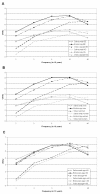A labelled discrete choice experiment adds realism to the choices presented: preferences for surveillance tests for Barrett esophagus
- PMID: 19454022
- PMCID: PMC2695479
- DOI: 10.1186/1471-2288-9-31
A labelled discrete choice experiment adds realism to the choices presented: preferences for surveillance tests for Barrett esophagus
Abstract
Background: Discrete choice experiments (DCEs) allow systematic assessment of preferences by asking respondents to choose between scenarios. We conducted a labelled discrete choice experiment with realistic choices to investigate patients' trade-offs between the expected health gains and the burden of testing in surveillance of Barrett esophagus (BE).
Methods: Fifteen choice scenarios were selected based on 2 attributes: 1) type of test (endoscopy and two less burdensome fictitious tests), 2) frequency of surveillance. Each test-frequency combination was associated with its own realistic decrease in risk of dying from esophageal adenocarcinoma. A conditional logit model was fitted.
Results: Of 297 eligible patients (155 BE and 142 with non-specific upper GI symptoms), 247 completed the questionnaire (84%). Patients preferred surveillance to no surveillance. Current surveillance schemes of once every 1-2 years were amongst the most preferred alternatives. Higher health gains were preferred over those with lower health gains, except when test frequencies exceeded once a year. For similar health gains, patients preferred video-capsule over saliva swab and least preferred endoscopy.
Conclusion: This first example of a labelled DCE using realistic scenarios in a healthcare context shows that such experiments are feasible. A comparison of labelled and unlabelled designs taking into account setting and research question is recommended.
Figures



References
-
- Drummond MF, O'Brien B, Stoddart GL, Torrance GW. Methods for the Economic evaluation of Health Care Programmes. Oxford: Oxford University Press; 1997.
Publication types
MeSH terms
LinkOut - more resources
Full Text Sources

